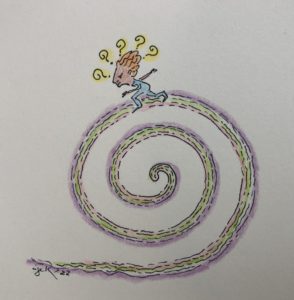
-Illustration © 2023 Jan Ketchel
The shamans of ancient Mexico coined the term internal dialogue to identify the incessant self-talk that we all engage in that generates our personality.
The content of the internal dialogue is the socialized messages we all receive from the moment we are born, which come to shape our perception and interpretation of ourselves, and the world around us.
What’s key is how the internal dialogue, which is largely internalized verbal and nonverbal messages from significant others, becomes the deeply felt personal definition of self that we accept as our unique personality. Thus, our sense of self is mostly simply a product of external forces of socialization. What we come to covet as our unique self is largely an arbitrary creation of external suggestion.
Psychologically this is what forms and upholds our ego identity. The ego adopts this external messaging as its internal dialogue, which instructs the subconscious mind to manifest the mental and physical being we then become in this world. The subconscious mind is capable of creating anything we say to it—its powers are that extraordinary.
This magic, however, is lost to us, as our magical possibilities are molded externally, and maintained internally, by the incessant unconscious repetition of the same internal dialogue.
Shamans call this fixation of identity, via suggestion, the assemblage point, where unlimited possibility becomes sharply bound by a definite sense of self. Carlos Castaneda called it the place where the wings of our magical selves become clipped.
To further complicate the potential awakening to our innate creative potential is the emotional security we derive from a consistent knowing of ourselves. Thus, for instance, if we are generally somewhat depressed and not hopeful about success in our lives, we may nonetheless cling to and defend this unhappy personality because it provides us with the security of a familiar, trustworthy sense of self.
The rational function of the ego will also likely generate persuasive arguments to dismiss the irrational notion of an unlimited magical potential within the self.
For instance, the subconscious mind is capable of nonlocal perception, such as through remote viewing, channeling or telepathy. The ego, on rational grounds, may dismiss these potential abilities with blocking beliefs that preclude ego even suggesting such a possibility to the subconscious mind.
The shaman proposes that one suspend judgment, and, like a true scientist, approach the subconscious with an unbiased experiment that presents suggestions to it and observes behavioral outcomes.
Too often we try first to reason with the internal dialogue to overcome its objections. This will almost always fail due to the power of the ego’s defenses, which it employs to securely maintain its familiar self.
Rather than battle with reason, accept the product of its internal dialogue, the current ego identity. Instead of an argument, create a new internal dialogue that you volitionally and incessantly repeat, as often as you remember.
For example, state the phrase, “I am calm,” thousands of times a day. It matters little if you believe it or not. In fact, your working definition of self—your standard operating self definition—might be, “I am an anxious person.” Do not challenge this definition, simply repeat, “I am calm,” as often as you can.
Suggestions given to the subconscious just before sleep are the most powerful. In retiring to sleep, both the physical body and the conscious mind are turning down and tuning out, thus the availability of the subconscious to receive new instructions is paramount.
In addition, the subconscious naturally comes alive to creativity and suggestion at night. Why waste it on ordinary dreaming? Give it some direction!
As one works the magic at night, one may soon discover that one is more calm in waking life as well. The more established ego state, which loves rationality, will likely take in this new fact and be willing to incorporate it into its old sense of self with little resistance. What ego would deny the facts of its own experience? That’s reality testing at its most basic level.
The possibility of molding a new sense of self, with consciousness that assumes personal responsibility for the suggestions presented to the subconscious, is the true key to the magical kingdom.
Firstly, it allows one to shed the propositions of early internalized beliefs that don’t truly reflect one’s innate potential. The ego instead becomes the beacon of the true Spirit of the Self.
Secondly, it puts the two minds within the self in an optimal relationship for growth. If the ego suggests, to the subconscious, actions of health, healing and the greater good, the physical body and the manifested world will reflect the instinct of self-preservation taken to the highest level of evolutionary refinement.
Thirdly, we, as human beings, are thus restored to the free exploration of our magical beingness and our greater creative potential. We unclip our wings with the free exercise of our will and become the true artists of our lives.
It’s that simple! Take charge of the internal dialogue and become all that you can be!
I am a being of unlimited potential,
Chuck




